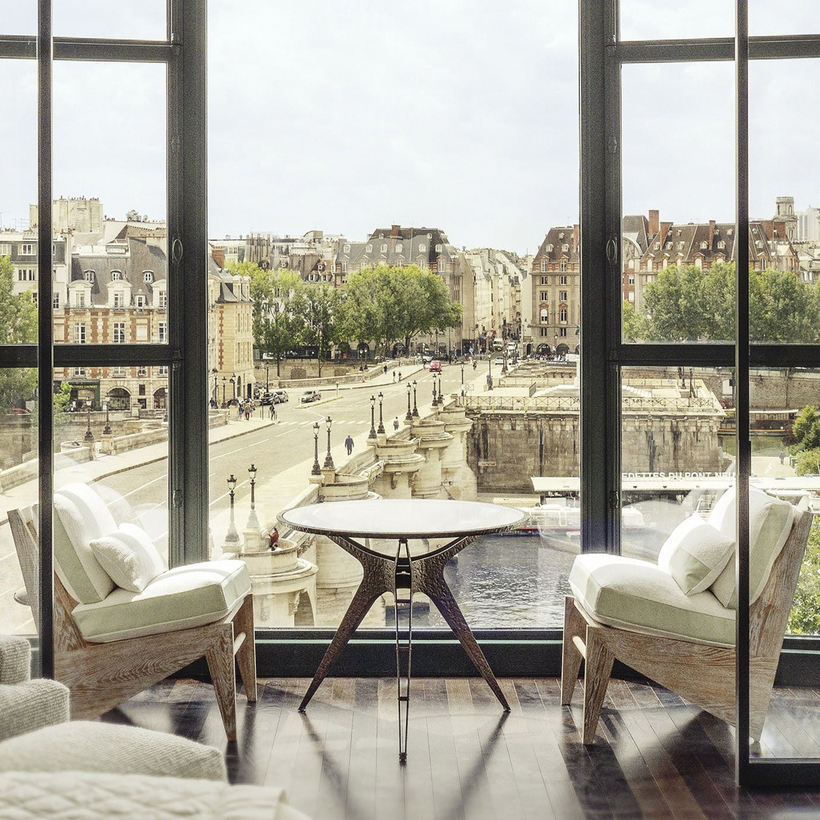The recently opened 72-room Cheval Blanc is the Louis Vuitton handbag of Paris hotels, and not just because it was conceived by luxury conglomerate LVMH.
This is why it’s fascinating to decipher the semiotics of this new address. What to make of the codes concealed in its profoundly plush and soothing champagne-ivory-and-sand-colored rooms, designed by Peter Marino?
Marino, an architect and interior designer known for a transgressively flashy sense of minimalism, designs between three and seven Louis Vuitton boutiques a year—most recently, the New Bond Street flagship in London. He reimagined Cheval Blanc in this sleek corporate tradition, discreetly nodding at the reality that much of the world’s new wealth will be generated in Asia and the Middle East during the 21st century.

Before Cheval Blanc became an $1,800-a-night luxury playpen, a different type of opulent, Parisian lodging had inspired the world’s ultimate desire. There were—and maybe still are, for some—the French capital’s Palace hotels, those legendary five-star places such as the Crillon or the Ritz that had black-and-white-marble-checkerboard and buffed-limestone floors, crystal chandeliers, tapestries and oil paintings on the walls, and Louis-something furniture.
Now this Gallic decorative grand slam is apparently considered too old-fashioned to resonate with titanium cardholders from places such as Baku and Baoding.
What’s wanted now is all-about-me modern pampering. So Cheval Blanc serves up a tantalizing menu of luxury-branded amenities, including a Dior Spa with six treatment rooms offering 43 different skin-care treatments, should one have the time.

This hotel was designed for guests who are just as interested in staying in as they are in seeing the city. Why bother with a walk along the Seine when there is an indoor pool with mosaic walls by Michael Mayer, a Rossano Ferretti hair salon (Ferretti is Kate Middleton’s favorite hairdresser), and four restaurants, including Plénitude, a gastronomic experience from chef Arnaud Donckele, who already has three Michelin stars at La Vague d’Or restaurant at Cheval Blanc St-Tropez? (Reservations there are booked solid until 2022.)
There is also an outpost of Langosteria, a branch of a well-known Italian seafood restaurant from the same holding company that owns Moncler.
The grandest amenity of all, however, may be the operatic views over the Seine and Paris, assuming you pony up for a high-floor riverside room with one of those glassed-in winter-garden balconies that just beg for a good selfie.

And because any luxury hotel is all about the details, staff uniforms here were designed by the Parisian fashion house Patou, and the soaring lobby resembles an art gallery with a sculpture of a rearing horse by Frank Gehry and works by Vik Muniz, Tony Cragg, Martin Kline, and Charlotte Perriand.
The best views of the city can be found at Le Tout-Paris, the rooftop brasserie, which may make Parisians of a certain age—like me—nostalgic for La Samaritaine, the department store that LVMH acquired 55 percent of in 2001 before buying the rest of the property in 2010. In the summer, we used to enjoy these Parisian panoramas for less than 20 francs (roughly $4), which was the price of a glass of white wine on the terrace at the time.
What followed was a complicated urban Cinderella story, as the store where generations of middle-class Parisians bought their first serious adult furniture—the solid stuff that didn’t quicken the pulse but was respected for its high quality—was renovated as a luxury hotel.

This was probably inevitable, too, because its original A-to-Z department-store retail model was doomed as families with children left Paris to live in the suburbs and the French capital’s economy spun ever harder on tourism and luxury goods.
As is true of many luxury boutiques along Sloane Street in London, Madison Avenue in New York, or in Saint-Germain-des-Prés in Paris, there’s filtering at the doors to Le Cheval Blanc, a reminder of how hard the centrifuge of gentrification has been spinning during the last 30 years. All three of the highly desirable big-city neighborhoods I once lived in—Greenwich Village, Fulham, and Saint-Germain-des-Prés—have long since been transformed beyond recognition.

But when it comes to Paris luxury hotels, a permanent wick of exclusivity and even the polite possibility of inaccessibility always incite votive desire, which is why Le Cheval Blanc has immediately become a Parisian institution. It’s the new hotel where even the most die-hard locals want to lay their heads, if only to see what all the fuss is about.
Alexander Lobrano is a Paris-based writer and restaurant critic. His latest book, the gastronomic coming-of-age story My Place at the Table, is out now


